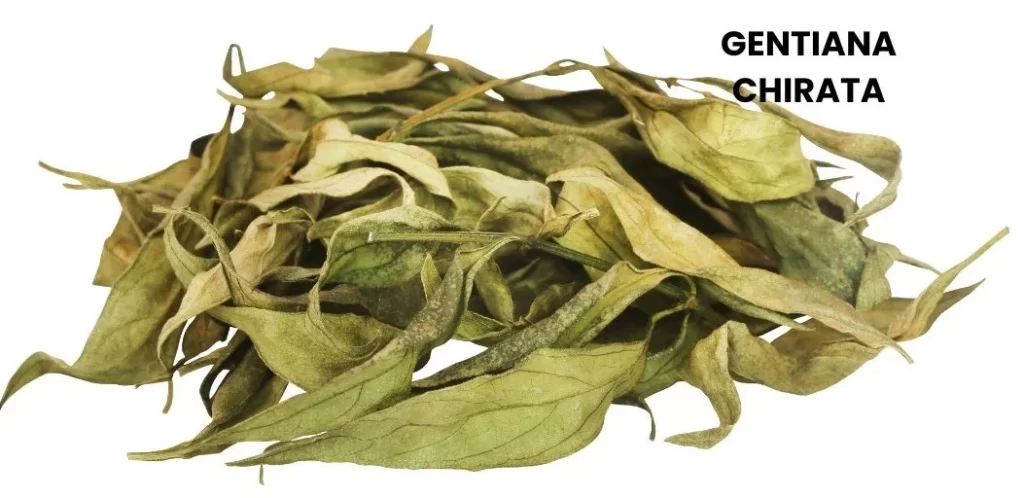Gentiana chirata, also known as Swertia chirata, is a plant from the Gentianaceae family, widely recognized for its therapeutic properties in both traditional and homeopathic medicine.
Commonly referred to by its local names such as Nela-verum, Kirata-tikta, and Chitrata, Chirata is indigenous to the Himalayan regions of India, Nepal, and Bhutan.
It has a long history of use in Ayurvedic and Unani medicine, primarily for its bitter tonic properties that support liver function and improve digestion.
In homeopathy, Gentiana chirata is especially valued for its anti-pyretic properties, making it effective against chronic fevers, and for treating various gastrointestinal and hepatic conditions.
This remedy was first proved by Dr. Kali Kumar Bhattacharjee, who highlighted its multifaceted therapeutic applications.
Common Names: Nela-verum, Kirata-tikta, Chitrata
First Prover: Dr. Kali Kumar Bhattacharjee

Table of Contents
ToggleSOURCE INFORMATION
Scientific Classification
- Kingdom: Plantae
- Order: Gentianales
- Family: Gentianaceae
- Genus: Swertia
- Species: Swertia chirata
Origin and Historical Facts
- Gentiana chirata, commonly known as Chirata or Swertia chirata, is a plant native to the Himalayan regions of India, Nepal, and Bhutan.
- Traditionally, it has been used in Ayurvedic and Unani medicine for its potent medicinal properties.
- Chirata is revered for its bitter taste and is often used as a tonic to support liver function and improve digestion.
- Historically, it has been utilized to treat fevers, dyspepsia, and a variety of gastrointestinal ailments.
- Dr. Kali Kumar Bhattacharjee was the first to prove its homeopathic uses.
Homoeopathic Application
- In homeopathy, Gentiana chirata is employed primarily as an anti-pyretic or febrifuge, making it effective against chronic fevers.
- It also addresses dyspepsia, hyperacidity, functional inactivity of the liver, flatulence, anorexia, and worm infestations.
DRUG PATHOGENESIS
- Gentiana chirata acts on various systems of the body, particularly targeting the digestive and hepatic systems.
- It stimulates liver function, enhances digestion, and has a notable effect on reducing fever.
- The remedy also influences the nervous system, providing relief from mental dullness and promoting a sense of well-being.
KEY CHARACTERISTICS
- Anti-pyretic: Effective in reducing fever.
- Digestive Aid: Treats dyspepsia, hyperacidity, and anorexia.
- Hepatic Stimulant: Improves liver function and alleviates flatulence.
- Vermifuge: Addresses worm infestations.
DETAILED ORGAN SYMPTOMS
Mind
- Dullness: A marked dullness of mind, with a strong desire to lie down.
Head
- Coldness: Sensation of coldness in the head.
- Pain: Dull pain in the temples extending gradually to the whole head.
Nose and Eyes
- Burning Sensation: Burning in the eyes and flushes of heat from the nostril.
Ear
- Hissing Sound: Persistent hissing sound in the ears.
Mouth
- Bad Taste: Unpleasant taste in the mouth in the morning.
- Foul Smell: Noticeable foul smell from the mouth.
Tongue
- Yellowish Coating: Yellowish coating on the tongue.
- Heaviness: Sensation of heaviness, difficulty in speech.
Throat
- Pain: Pain in the throat, alleviated by hot drinks.
- Dry Cough: Dry, hacking cough.
Abdomen
- Flatulence: Significant flatulence.
- Pain: Pain with enlarged liver and spleen, especially right-sided renal pain.
- Cravings: Strong desire for butter and meat.
Urinary Organs
- Red Urine: Red-coloured urine with a burning sensation during urination.
Male Sexual System
- Weakness: Weakness of sexual power, slight discharge of semen.
Extremities
- Aching Pain: General aching pain in the extremities.
- Weakness: Weakness in the legs, difficulty in walking.
Fever
- Cold Stage: Coldness with nausea and bile vomiting, lasting long.
- Hot Stage: Hot stage lasts 3 to 4 hours, followed by sweating.
- Thirst: Strong desire for hot water after the cold stage.
MODALITIES
- Aggravation: Symptoms worsen during the cold stage of fever.
- Amelioration: Symptoms improve with hot drinks.
WHAT ARE MODALITIES IN HOMOEOPATHY?
RELATIONSHIP WITH OTHER DRUGS
- Compare: Similar to other fever remedies such as Cinchona (China) and Nux vomica (Nux v.).
DOSE
- Potency of Choice: Mother tincture, 3x, 6.
Frequently Asked Questions
What is Gentiana chirata used for?
- Gentiana chirata is primarily used for its anti-pyretic properties to reduce fever.
- It also treats digestive issues like dyspepsia and hyperacidity, supports liver function, alleviates flatulence, and addresses worm infestations.
Is Gentiana chirata safe to use?
- When used in recommended homeopathic potencies, Gentiana chirata is safe for most individuals.
- However, consulting with a qualified homeopathic practitioner for proper dosage and administration is advisable.
What are the side effects of Gentiana chirata?
- Side effects are rare when used in homeopathic potencies.
- Overdosing or using the remedy inappropriately may cause aggravation of symptoms or gastrointestinal discomfort.
Glossary of Difficult Words
- Anti-pyretic: A substance that reduces fever.
- Febrifuge: A medication that reduces fever.
- Dyspepsia: Indigestion or difficulty in digesting food.
- Hyperacidity: Excessive acid in the stomach.
- Flatulence: The accumulation of gas in the digestive system.
- Anorexia: Lack or loss of appetite for food.
- Vermifuge: A medication or substance used to expel parasitic worms from the body.
- Sub-involution: The incomplete return of an organ to its normal size after childbirth.
- Scrobiculum: The pit of the stomach or the region of the upper abdomen.
- Constitution: In homeopathy, the physical and psychological makeup of a person, which influences their response to remedies.
This comprehensive drug picture of Gentiana chirata provides a detailed overview of its uses, symptoms, and application in homeopathy.
